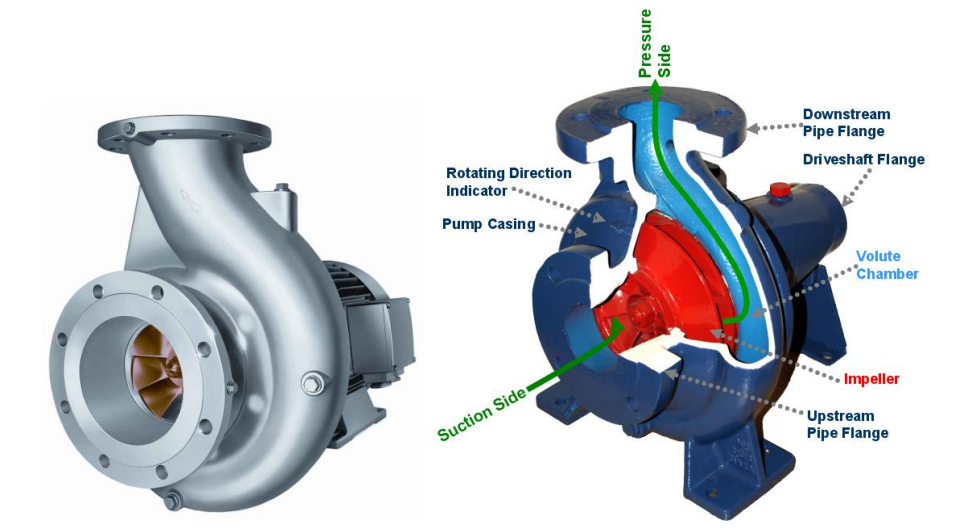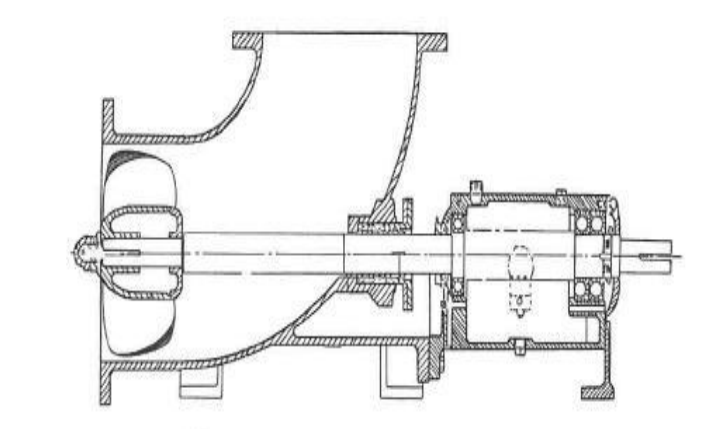Performance of centrifugal or centrifugal pumps
A centrifugal pump operates by converting the kinetic energy of a flowing fluid into static pressure, a process described by Bernoulli’s principle. The working mechanism of centrifugal pumps can be illustrated by considering the effect of shaking a bucket of water in a circular motion using a rope. The force that pushes the water to the bottom of the bucket is known as centrifugal force. If a hole is made in the bottom of the bucket, water will flow through this opening. Furthermore, if an inlet pipe is installed at the top of the bucket, the outflow of water through the hole will create a local vacuum inside the bucket. This vacuum will draw water from a source connected to the inlet pipe into the bucket. Consequently, there is a continuous flow from the source to the outside of the bucket. In the context of centrifugal pumps, the bucket and its cover represent the pump casing, the hole and the inlet pipe correspond to the pump’s inlet and outlet, while the rope and arm perform the function of the impeller.
What is a centrifugal pump?
A centrifugal pump is a device that utilizes a rotating impeller to increase the pressure of a fluid. These pumps are commonly employed to transport fluids through piping systems. The fluid, entering the pump impeller along or near the rotating axis, is accelerated by the impeller and rapidly flows outward into a diffuser or spiral chamber, from which it exits into the downstream piping system. Centrifugal pumps feature a snail-shaped housing known as a shell or casing, which contains one or more impellers mounted on a shaft. Each impeller is equipped with several blades that facilitate energy transfer to the fluid. To prevent leakage of the fluid from the pump casing at the shaft exit, a mechanical seal is employed. An essential aspect of operating these pumps is the process of priming, which involves removing any air or gas trapped inside the pump before it is turned on. After positioning the pump and ensuring that the fluid can enter, it is crucial to expel all air or gas to ensure optimal performance. Centrifugal pumps are available in various sizes and dimensions to accommodate different applications. Reason: Improved clarity, vocabulary, and technical accuracy while maintaining the original meaning.
Centrifugal pump classification
1. Radial flow pumps:
In this type of centrifugal pump, fluid pressure increases only by applying centrifugal force. The pumps of this category have a specific speed of less than 4200 with a series of inlet propellers and two series of suction propellers with a specific speed of less than 6000. In these pumps, the fluid usually enters the impeller through a hub and flows radially to the environment.

2. Mixed flow pump:
In these pumps, the pressure is increased to some extent by the application of centrifugal force and to some extent by the application of lift force applied by the blades. This category of pumps has a series of inlet impellers with axial output flow, and discharge is done in axial and radial directions. Pumps of this category usually have a specific speed between 4200 and 9000.
3. Axial flow pump:
The axial flow pump from the category of centrifugal pumps, which are sometimes called propeller pumps, applies the greatest increase in fluid pressure through the application of propellers or the operation of lifting blades. This group has a series of inlet impellers with axial inlet flow and almost axial outlet. Pumps of this group often have special speeds of more than 9000. In general, axial flow pumps are used when pressure increase is necessary, and radial flow pumps are used to produce flow rate.

Advantages and disadvantages of centrifugal pump
One of the advantages of the centrifugal pump is the feature of producing a smooth and uniform flow. Some types of centrifugal pumps also pump some sand and are generally reliable and have a good working life. Among the disadvantages of these pumps, we can mention the loss of the quality level of the start-up, which occurs after the start-up. Also, the efficiency of these pumps depends on the work under head and design speed. In setting up a centrifugal pump, since these pumps use suction, they cannot pump air. So, as a result, the pump and pipe must be full of water so that no problem occurs in the water pump.

